|
|
 |
|
Calanoida ( Order ) |
|
|
|
Clausocalanoidea ( Superfamily ) |
|
|
|
Aetideidae ( Family ) |
|
|
|
Undeuchaeta ( Genus ) |
|
|
| |
Undeuchaeta plumosa (Lubbock, 1856) (F,M) | |
| | | | | | | Syn.: | Undina plumosa Lubbock, 1856;
Euchaeta australis Brady, 1883 (p.65, figs.F,M); T. Scott, 1894 b (p.58);
Undeuchäta minor Giesbrecht, 1888; 1892 (p.228, 232, figs.F);
Undeuchaeta minor : Giesbrecht & Schmeil, 1898 (p.34); Giesbrecht & Schmeil, 1898 (p.34); Cleve, 1904 a (p.198); Esterly, 1905 (p.149, figs.F); Pearson, 1906 (p.15, Rem.); Van Breemen, 1908 a (p.44, fig.F); Farran, 1908 b (p.37); With, 1915 (p.132, figs.F,M); Willey, 1919 (p.178); Farran, 1920 (p.18); Lysholm & Nordgaard, 1921 (p.16); Bigelow, 1926 (p.295); Farran, 1926 (p.253); 1929 (p.208, 233, Rem.); Wilson, 1932 a (p.61, figs.F,M); Oliveira, 1945 (p.191); Sewell, 1948 (p.519); Chiba, 1956 (p.53, figs.F); Chiba & al., 1957 (p.308); Timonin, 1971 (p.281, trophic group);
Undeuchaete minor : Giesbrecht, 1892 (p.228, 232, figs.F); Thompson & Scott, 1903 (p.233, 244); Esterly, 1905 (p.149, figs.F); With, 1915 (p.132, figs.F,M); Farran, 1926 (p.253); 1929 (p.233);
U. australis : Sars, 1905 b (p.4);
U. intermedia : Bradford, 1970 (p.354, fig.8: F). | | | | Ref.: | | | A. Scott, 1909 (p.62, figs.M, Rem.F,M); Sars, 1925 (p.79, Rem.F,M); Rose, 1929 (p.24); 1933 a (p.108, figs.F,M); 1936 a (p.89); Mori, 1937 (1964) (p.41, figs.M); Jespersen, 1940 (p.26); Lysholm & al., 1945 (p.19); C.B. Wilson, 1950 (p.348, fig.M, Rem.F); Brodsky, 1950 (1967) (p.182, figs.F,M); Vervoort, 1952 h (n°49, p.3, figs.F,M); Tanaka, 1957 b (p.199, figs.F,M); Vervoort, 1957 (p.70, Rem.); Grice, 1962 (p.199, figs.F,M); Vervoort, 1963 b (p.154); Owre & Foyo, 1967 (p.50, figs.F,M); Park, 1968 (p.551); Ramirez, 1969 (p.61, figs.M); Bradford, 1970 a (p.354, fig.M); Tanaka & Omori, 1970 b (p.145); Corral Estrada, 1970 (p.153, figs.F); Bradford, 1972 (p.40, figs.F); Bradford & Jillett,1980 (p.83, figs.F,M, fig.73, distribution chart); Björnberg & al., 1981 (p.605, 632, figs.F,M); Markhaseva, 1996 (p.310, figs.F,M); Chihara & Murano, 1997 (p.689, Pl.48,49: F,M); Bradford-Grieve & al., 1999 (p.879, 923, figs.F,M); Conway & al., 2003 (p.178, figs.F,M, Rem.); Mulyadi, 2004 (p.52, figs.F,M, Rem.); Vives & Shmeleva, 2007 (p.605, figs.F,M, Rem.) | 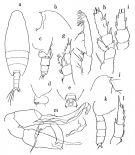 issued from : O. Tanaka in Publ. Seto Mar. Biol. Lab., 1957 b, 6 (2). [Fig.58, p.200]. Female (from Sagami & Suruga): a, habitus (dorsal aspect); b, head (lateral aspect); c, last thoracic segment and urosome (lateral aspect); d, last thoracic segment and genital segment (lateral aspect, right side); e, idem (ventral aspect); f, Mxp.; g, P1; h, P2; i, endopodite of P4. Male: j, head (lateral aspect); k, last thoracic segment and urosome (lateral aspect); l, exopodite of P1; m, P5. Nota Female: - Cephalothorax about 3.5 times the abdomen length (2.8 : 0.81). - Head and 1st pedigerous segment fused, 4th and 5th pedigers fused. - Posterolateral corners of the last thoracic segment asymmetrical; left side produced bluntly triangularly . - Rostrum short and stout, directs downwards. - Abdomen 4-segmented; segments and caudal rami in the proportional lengths 45 : 24 : 20 : 2 : 9 = 100. - Genital segment asymmetrical , with a dorsal spine on the right margin about the middle, and a row of hairs on the distal corner; left lateral marginwith near the base a low protuberance or something like cement substance which runs posteriorly about to the 2/3 of the segment; the lateral distal corners of the segment furnished with groups of short hairs. - A1 23-segmented, extends to distal end of genital segment. - A2 exopod 2 times as long as endopod. - Mx1 with 9 setae on outer lobe, of which the proximal 4 are short; exopod with 11 setae, of which 4 are longer. - Mxp 2nd basal segment about 2 times as long as the 1st; endopod half the length of 1st basal segment. - P1 exopodal segments 1 and 2 fused. - P2 endopod 1-segmented; outer edge spine on proximal margin of endopod with an accessory tooth. - P3 and P4 each endopod 3-segmented. - Terminal spine of exopod of P2 to P4 with 32, 26 and 26 teeth, respectively. Nota Male: - Abdomen contained 2.7 times in the length of cephalothorax. - Posterolateral corners of last thoracic segment rounded. - Rostrum short, directs straight downwards. - Abdomen 5-segmented; segments and caudal rami in proportional lengths 23 : 30 : 26 : 20 : 2 : 9 = 100. - Anal segment very short, concealed beneath the 4th segment. - 2nd and 3rd abdominal segments furnished with minute teeth on posterior margin. - 2nd caudal seta about 2 times as long as the others; appendicular seta very short. - A1 21-segmented, extends to distal end of last thoracic segment. - P1 with a short outer edge spine on 2nd exopodal segment. - P2 outer marginal spine on 2nd and 3rd exopodal segments of equal lengths. - P5 very characteristic; endopod of left leg about as long as 1st exopodal segment; in right leg 2nd basal segment (= basis) longer than 1st exopodal segment; 3rd exopodal segment elongated.
|
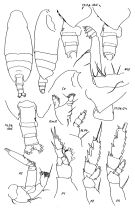 issued from : E.L. Markhaseva in Proc. Zool. Inst. RAN, St. Petersburg, 1996, 268. [p.38, Fig.248]. Female (from NE Atlant.). Ce: forehead (lateral); P.md: mandibular palp; RiP4: coxopod (partial), basipod (partial) and endopod.
|
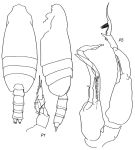 issued from : E.L. Markhaseva in Proc. Zool. Inst. RAN, St. Petersburg, 1996, 268. [p.309, Fig.249]. Male (from NE Atlant.)
|
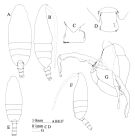 issued from : J.M. Bradford & J.B. Jillett in Mem. N.Z. oceanogr. Inst., 86, 1980. [p.84, Fig.58]. Female: A, habitus (dorsal); B, idem (lateral right side); C, genital segment (lateral right side); D, idem (dorsal). Male: E, habitus (dorsal); F, idem (lateral left side); G, P5.
|
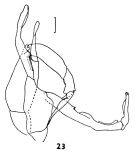 issued from : J.M. Bradford in N.Z. Jl Mar. Freshw. Res., 1970, 4 (4). [p.354, Fig. 23]. Male (off Kaikoura, New Zealand): 23, P5. Scale bar represents 0.1 mm.
|
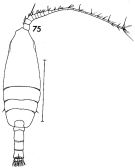 issued from : F.C. Ramirez in Contr. Inst. Biol. mar., Buenos Aires, 1969, 98. [p.62, Lam. XI, figs.75 ]. Male (from off Mar del Plata): 75, habitus (dorsal). Scale bar in mm: 1.5.
|
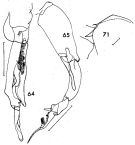 issued from : F.C. Ramirez in Contr. Inst. Biol. mar., Buenos Aires, 1969, 98. [p.60, Lam. X, figs.64, 65, 71 ]. Male (from off Mar del Plata): 64, right P5 (distal segments, ventral view); 65, left P5 (distal segments); 71, forehead (lateral). Scale bars in mm: 0.3 (64, 65); 0.05 (71).
|
 issued from : J. Corral Estrada in Tesis Doct., Univ. Madrid, A-129, Sec. Biologicas, 1970. [Lam.43, figs.1-2]. Female (from Canarias Is.): genital segment (dorsal); 2, idem (ventral).
|
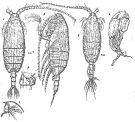 Issued from : G.O. Sars in Résult. Camp. Scient. Prince Albert I, 69, pls.1-127 (1924). [Pl.XXIII, figs.1-6]. Female: 1, habitus (dorsal); 2, idem (lateral left side); 3, forehead (lateral); 4, posterior corner cephalothorax and genital segment (lateral right side). Male: 11, habitus (lateral left side); 12, P5.
|
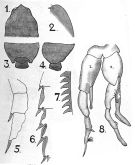 issued from : A. Scott in Siboga-Expedition, 1909, XIX a. [Plate XXII, Figs.1-8]. Male (from Indonesia-Malaysia): 1, forehead (dorsal); 2, idem (lateral); 3, last thoracic and genital segments (dorsal); 4, idem (left side); 5, P1 (exopodite only); 6, P2 (outer margin of exopodite; 7, part of terminal spine of exopodote of P3; 8, P5.
|
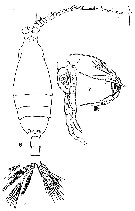 issued from : T. Mori in The pelagic Copepoda from the neighbouring waters of Japan, 1937 (2nd edit., 1964). [Pl.17, Figs.6-7]. As Undeuchaeta minor. Male: 6,habitus (dorsal); 7, P5 (anterior).
|
 issued from : C.O. Esterly in Univ. Calif. Publs Zool., 1905, 2 (4). [p.149, Fig.17]. As Undeuchaeta minor. Female (from San Diego): a, habitus (lateral); b, P2. Nota: Head without crest. Genital segment with 1 spine on the dorsal surface.
|
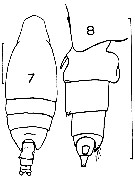 issued from : J.M. Bradford in Mem. N. Z. Oceonogr. Inst., 1972, 54. [p.41, Fig.8, (7-8)]. Female (from Kaikoura, New Zealand): 7, habitus (dorsal); 8, urosome (lateral, right side). Scale bars: 1 mm. Nota: Distinguishable from U. major Giesbrecht, by the lack of a sharp spine on the ventral surface of the genital segment.
|
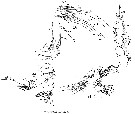 Issued from : W. Giesbrecht in Systematik und Faunistik der Pelagischen Copepoden des Golfes von Neapel und der angrenzenden Meeres-Abschnitte. – Fauna Flora Golf. Neapel, 1892. Atlas von 54 Tafeln. [Taf. 14, Figs.31-34 ]. As Eudeuchäta minor. Female: 31, Mx1 (anterior view, several setae on the inner lobe 1 and endopod are omitted); 32, P2 (posterior view); 33, A2 (anterior view); 34, Mxp (B1: posterior view, rest: anterior view).
|
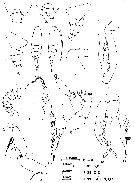 issued from : G.D. Grice in Fish. Bull. Fish and Wildl. Ser., 1962, 61. [p.198, Pl.12, Figs.1-14]. Female (from equatorial Pacific): 1-2, genital segment (dorsal and ventral, respectively); 3-4, posterior part of thorax and urosome (left side and right side, respectively). Nota: Presence of a spine on the right side of the genital segment. Male: 5-6, habitus (dorsal and lateral, respectively); 7, forehead (lateral); 8, A2; 9, Mx1 (part.); 10, Mxp ( setae on distal part omitted); 11, P1; 12, P5; 13, terminal part of left P5; 14, right P5 (part.).
|
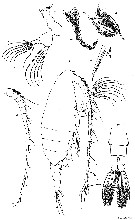 Issued from : G.S. Brady in Rep. Scient. Results Voy. Challenger, Zool., 1883, 8 (23). [Pl.XXI, Figs.5-11]. As Undeuchaeta australis. Female: 5, habitus (lateral); 7, Md; 10, urosome; 11, terminal spines of one of the swimming legs. Male: 6, A1; 8, right P5; 9, left P5.
|
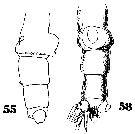 Issued from : W. Giesbrecht in Systematik und Faunistik der Pelagischen Copepoden des Golfes von Neapel und der angrenzenden Meeres-Abschnitte. - Fauna Flora Golf. Neapel, 1892, 19 , Atlas von 54 Tafeln. [Taf.37, Figs.55, 58]. As Undeuchäta minor. Female: 55, urosome (lateral); 58, same (ventral).
|
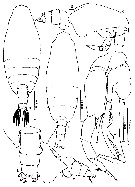 issued from : Mulyadi in Published by Res. Center Biol., Indonesia Inst. Sci. Bogor, 2004. [p.53, Fig.28]. Female (from Flores Sea): a, habitus (dorsal); b, posterior corners of last thoracic segment and urosome (dorsal); c, forehead (lateral); d, posterior corner of last thoracic segment and urosome and urosome (lateral right side; e, same (lateral left side). Male: f, habitus (dorsal); g, P5.
|
 Undeuchaeta plumosa Undeuchaeta plumosa female: 1 - Cephalon without crest. 2 - Posterior corners of last thoracic segment not always triangular: right one usually rounded. 3 - Genital segment without spine on genital field (lateral view).
|
 Undeuchaeta plumosa Undeuchaeta plumosa male: 1 - Cephalon without crest. 2 - Endopodite of left P5 not reaching the distal border of exopodal segment 2. The second third of endopodite external border without teeth-like projections
|
 issued from : O. Tanaka in Publ. Seto Mar. Biol. Lab., 1957 b, 6 (2). [p.201]. Female A1: segments proportional lengths. Segment 17 the longest; last two segments of equal lengths (23 and 24-25) - A1 23-segmented; extends to distal end of genital segment
|
 issued from : O. Tanaka in Publ. Seto Mar. Biol. Lab., 1957 b, 6 (2). [p.201]. Male A1: segments proportional lengths. Articular membranes faintly visible between segments 9 and 10, and between segments 12 and 13. - A1 21-segmented; extends to distal end of last thoracic segment.
| | | | | Compl. Ref.: | | | Wilson, 1942 a (p.210); Sewell, 1948 (p.348, 513, 520, 545, 566); Fagetti, 1962 (p.21); Grice, 1963 a (p.495); Gaudy, 1963 (p.23, Rem.); Unterüberbacher, 1964 (p.22); De Decker & Mombeck, 1964 (p.14); Grice & Hulsemann, 1965 (p.223); 1967 (p.15); Furuhashi, 1966 a (p.295, vertical distribution in Oyashio/Kuroshio transitional area, Table 8, 10); Fleminger, 1967 a (tabl.1); De Decker, 1968 (p.45); Morris, 1970 (p.2300); Park, 1970 (p.476); Gueredrat, 1971 (p.300, fig.3, 10, Table 1, 2); Roe, 1972 (p.277, tabl.1, tabl.2); 1972 a (p.341); Bainbridge, 1972 (p.61, Appendix Table III: occurrence); Björnberg, 1973 (p.325, 389); Corral Estrada & Pereiro Muñoz, 1974 (tab.I); Gaudy, 1975 (p.109, Table I, respiration); Vives & al., 1975 (p.41, tab.II, III, IV, XII); Deevey & Brooks, 1977 (p.256, tab.2, Station "S"); Carter, 1977 (1978) (p.35); Dessier, 1979 (p.205); Svetlichnyi, 1980 (p.28, Table 1, passive submersion); Pipe & Coombs, 1980 (p.223, vertical occurrence); Vives, 1982 (p.291); Brenning, 1983 (p.5, Rem.); Dessier, 1983 (p.89, Tableau 1, Rem., %); Tremblay & Anderson, 1984 (p.4, Rem.); De Decker, 1984 (p.316, 365: chart); Cummings, 1984 (p.163, Table 2); Guangshan & Honglin, 1984 (p.118, tab.); Roe, 1984 (p.357); Brenning, 1985 a (p.28, Table 2); Madhupratap & Haridas, 1986 (p.105, tab.1); Rudyakov, 1986 (tab.2); Lozano Soldevilla & al., 1988 (p.58); Heinrich, 1990 (p.17); Suarez & al., 1990 (tab.2); Suarez & Gasca, 1991 (tab.2); Hattori, 1991 (tab.1, Appendix); Suarez, 1992 (App.1); Hays & al., 1994 (tab.1); Shih & Young, 1995 (p.67); Kotani & al., 1996 (tab.2); Suarez-Morales & Gasca, 1998 a (p108); Mauchline, 1998 (tab.64); Lopez-Salgado & al., 2000 (tab.1); Lapernat, 2000 (tabl.3, 4); Razouls & al., 2000 (p.343, Appendix); Haury & al., 2000 (p.69, Table 1); d'Elbée, 2001 (tabl. 1); Holmes, 2001 (p.51); Sameoto & al., 2002 (p.13); Beaugrand & al., 2002 (p.1692); Beaugrand & al., 2002 (p.179, figs.5, 6); Hsiao & al., 2004 (p.325, tab.1); Pusch & al., 2004 (251, tab.3); Gallienne & al., 2004 (p.5, tab.3); CPR, 2004 (p.63, fig.192); Lo & al., 2004 (p.89, tab.1); Berasategui & al., 2005 (p.313, fig.2); Ikeda & al., 2006 (p.1791,Table 2); Hwang & al., 2007 (p.23); Dur & al., 2007 (p.197, Table IV); Fernandes, 2008 (p.465, Tabl.2 as U. plumosa); Gaard & al., 2008 (p.59, Table1, N Atlantic Mid-Ridge); Lan Y.C. & al., 2008 (p.61, Table 1, % vs stations); Tseng L.-C. & al., 2008 (p.153, Table 2, fig.5, occurrence vs geographic distribution); Galbraith, 2009 (pers. comm.); Park & Ferrari, 2009 (p.143, Table 5, Appendix 1, biogeography); C.E. Morales & al., 2010 (p.158, Table 1); Williamson & McGowan, 2010 (p.273, Table III, Pacific central gyres: N & S); Medellin-Mora & Navas S., 2010 (p.265, Tab. 2); Hsiao S.H. & al., 2011 (p.475, Appendix I); Tseng L.-C. & al., 2011 (p.47, Table 2, occurrences vs mesh sizes); in CalCOFI regional list (MDO, Nov. 2013; M. Ohman, comm. pers.); Hirai & al., 2013 (p.1, Table I, molecular marker); Sano & al., 2013 (p.11, Table 2, fig.5, feeding habits); Lidvanov & al., 2013 (p.290, Table 2, % composition); Hwang & al., 2014 (p.43, Appendix A: seasonal abundance); Bonecker & a., 2014 (p.445, Table II: frequency, horizontal & vertical distributions); El Arraj & al., 2017 (p.272, table 2); Belmonte, 2018 (p.273, Table I: Italian zones); Acha & al., 2020 (p.1, Table 3: occurrence % vs ecoregions); Hirai & al., 2020 (p.1, Fig. 5: cluster analysis (OTU), spatial distribution). | | | | NZ: | 22 | | |
|
Distribution map of Undeuchaeta plumosa by geographical zones
|
| | | | | | | | | | | | | | | | | | 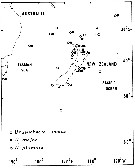 Issued from : J.M. Bradford & J.B. Jillett in New Zealand Ocean. Inst. Memoir, 86, 1980. [p.90-91, Fig.69]. Issued from : J.M. Bradford & J.B. Jillett in New Zealand Ocean. Inst. Memoir, 86, 1980. [p.90-91, Fig.69].
Distribution of several species of Undeuchaeta in the Tasman Sea and around New Zealand. |
 Issued from : P.-E. Lapernat in DEA Océanogr. Biol., Univ. P. & M. Curie, Paris VI. July 5, 2000. [Fig.13]. Issued from : P.-E. Lapernat in DEA Océanogr. Biol., Univ. P. & M. Curie, Paris VI. July 5, 2000. [Fig.13].
Verical distribution of Undeuchaeta plumosa at eutrophic (Mauritania coast: 20°32' N, 18°36' W) (1 from night and 2 from day) and oligotrophic site (off NW Cape Verde Islands: 21° N, 31° W) (3 from night and 4 from day) in females (F) and males (M) (ind. per m3) in the day (white circle) and night (black circle).
Nota: Sampling in the water column 0-1000 m, one during the day and another during the night with BIONESS multiple-net: 0-75; 75-150; 150-250; 250-350; 350-450; 450-550; 550-700; 700-850; 850-965 m. In May-June 1992. |
| | | | Loc: | | | sub-Antarct. (Indian, SW & SE Pacif.), South Africa (E & W), Namibia, off Tristan da Cunha Is., Congo, off da Trinidade Is., G. of Guinea, off Lagos, Cape Verde Is., off Mauritania-NW Cape Verde Is., off Morocco-Mauritania, Great Meteor Seamount, Canary Is., off Madeira, off W Azores, Argentina, Brazil, off Rio de Janeiro, off Amazon, Barbados Is., Caribbean Sea, Caribbean Colombia, G. of Mexico, Florida, off Bermuda: Station "S" (32°10'N, 64°30'W), Sargasso Sea, off Woods Hole, off E Nova Scotia, G. of St. Lawrence, S Iceland, Wyville Thomson Ridge, Faroe, W Ireland, off SW Ireland, North Sea, Bay of Biscay, off W Cabo Finisterre, Portugal, Ibero-moroccan Bay, W Medit. (Banyuls, S Central Basin, Thyrrhenian Sea), Natal, Madagascar (Nosy Bé), Mascarene Basin, Rodrigues Is. - Seychelles, Indian, S Indian (subtropical convergence), Bay of Bengal, Indonesia-Malaysia, Flores Sea, China Seas (East China Sea, South China Sea), Taiwan (SW, S, N: Mienhua Canyon), Japan, Sagami Bay, off Sanriku, off Hokkaido SE, Okhotsk Sea, Mariana & Izu-Bonin Trench, Pacif. (W equatorial), Pacif. (equatorial, central subtropical N), Pacific (central gyres: N & S), Australia (Great Barrier), off S Australia, New Zealand (Kaikoura), Bikini Is., off S Hawaii, California, off Peru, Pacif. (SE tropical), Chile (N & S, Concepcion).
Type locality: Atlantic. | | | | N: | 151 | | | | Lg.: | | | (1) F: 4 ; M: 3,2; (5) F: 4,5-3,5; M: 3,6-3,2; (7) F: 4,65; M: 3,93; (14) F: 3,85-3,3; M: 3,35-2,85; (34) F: 3,5-3,25; (35) F: 3,7-3,5; (37) F: 4,2-3; M: 3,9-2,85; (38) F: 4,25-3,95; M: 3,9-3,42; (56) F: 3,61; M: 3,45; (72) F: 4,12-3,74; M: 3,72-3,55; (101) F: 3,47; 3,41; M: 3,52; (105) F: 3,8-3,6; (112) F: 4-3,3; M: 3,7-3; (116) F: 4,06; (142) F: 3,18; (199) F: 4,41-3,34; M: 3,52-3,04; (201) F: 4,3-3,5; M: 3,7-2,8; (202) F: 3,2-4,5; M: 2,9-3,9; (254) M: 3; (313) M: 3,5; (432) F: 4,17; (991) F: 3-4,2; M: 2,85-3,9; (1109) F: 3,5-3,8; (1122) F: 3,62; M: 3,45; {F: 3,00-4,65; M: 2,80-3,93} | | | | Rem.: | epi-mesopelagic. Considered as vertical migrator.
Sampling depth (sub-Antarct.): 0-750 m. Sargasso Sea: 0-1500 m (Deevey & Brooks, 1977, station "S"). 298-526 m at Station N-1 (SW Bösö, E middle Japan) from Furuhashi (1966 a). 390-400 m (Pipe & Coombs, 1980 at 60°N, 07°W).
For Vervoort (1957, p.71) this species occurs from South of Tasmania (44°05'S, 147°35'E), far to the North of the Antarctic convergence, mainly restricted to moderately deep water layers, occasionally penetrating into deeper waters; at the surface the species is sometimes found in appreciable quantities, especially during the night.
Timonin (1971, p.282) considers the trophic interrelations in the equatorial and tropical Indian Ocean, and divides the plankters into 6 trophic groups from the litterature and the results of studies of mouth-parts structure and intestine content. This species is omnivorous.
After Sano & al. (2013, p.14, Table 2) atomic C:N ratio (mean ±SD) = 5.5 ±0.7, n =8.
See in DVP Conway & al., 2003 (version 1) | | | Last update : 25/10/2022 | |
|
|
 Any use of this site for a publication will be mentioned with the following reference : Any use of this site for a publication will be mentioned with the following reference :
Razouls C., Desreumaux N., Kouwenberg J. and de Bovée F., 2005-2025. - Biodiversity of Marine Planktonic Copepods (morphology, geographical distribution and biological data). Sorbonne University, CNRS. Available at http://copepodes.obs-banyuls.fr/en [Accessed January 01, 2026] © copyright 2005-2025 Sorbonne University, CNRS
|
|
 |
 |





















